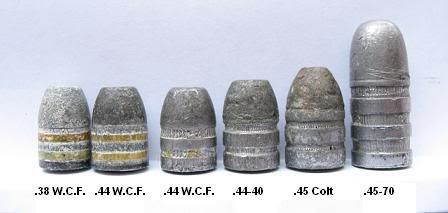Recently I was given about 100 rounds of very old factory ammo for the 44 WCF (44-40). Some were UMC but most were WRA head stamped. For the sake of knowledge, I broke on of each down and here is what I found;
WRA 44 WCF
40 grains of black powder
195 grain bullet that had two shallow round bottom lube grooves and the case was rounded
The lube was a yellow green sticky stuff that was still in good shape.
The bullet measured .427 on the top two bands and .429 on the bottom driving band
The alloy was 8 BHN in hardness.
UMC 44 CFW
35 grains of black powder
194 grain bullet identical in appearance to the above
The lube had dried to a hard white chalk
The bullet measured .425 on the top two bands and .427 on the bottom driving band
The alloy was 13.5 BHN
Anyway, I thought I would pass this on to anybody who find this stuff interesting.

|
   
   
|


|




 Reply With Quote
Reply With Quote


















